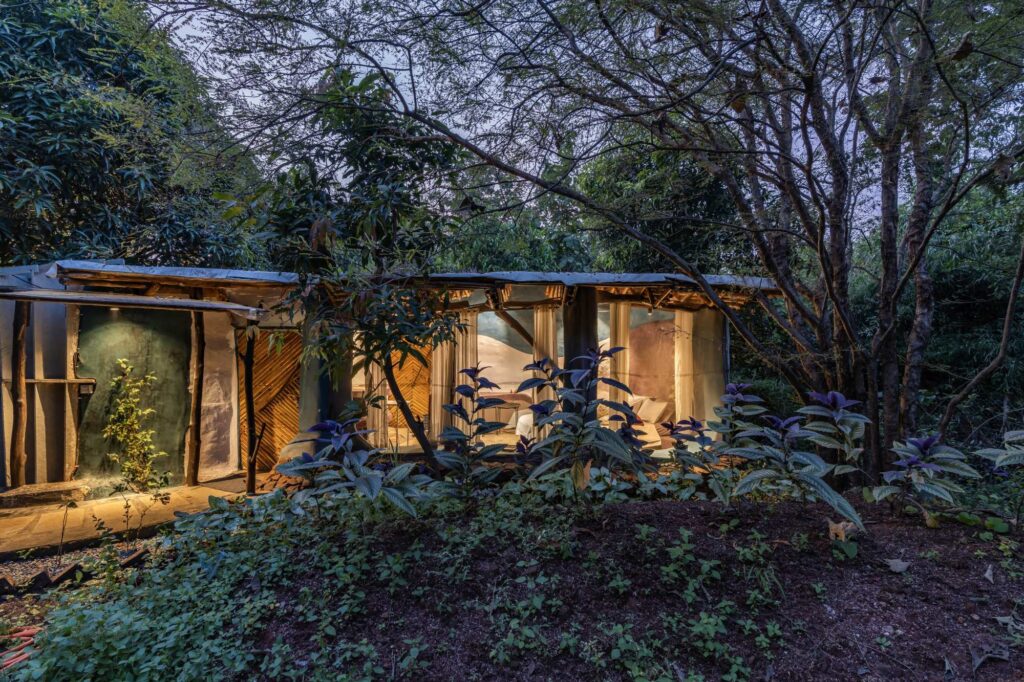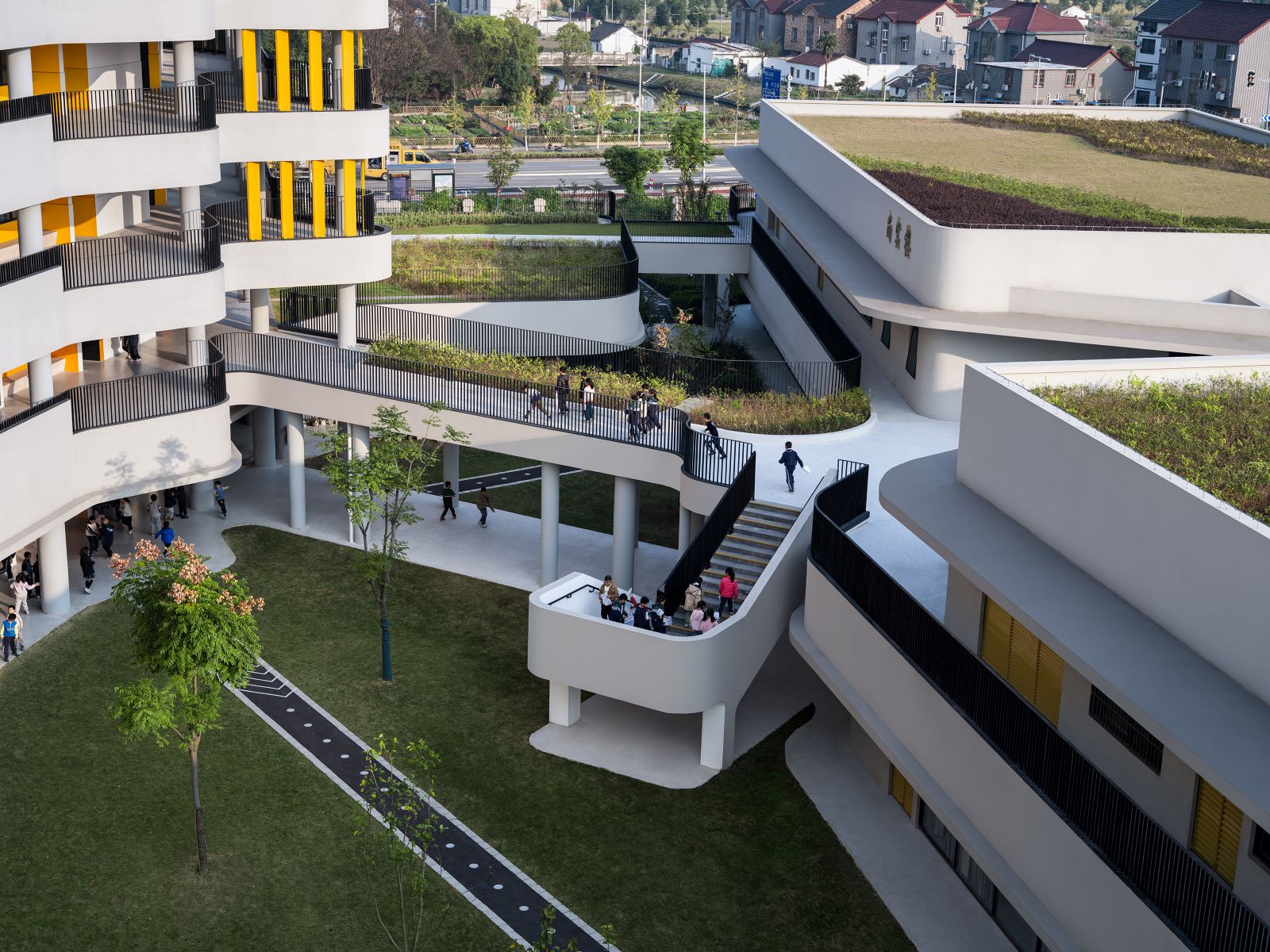
Maativan is a serene haven constructed from mud, harmoniously blending with the surrounding forest. This exquisite farmhouse, located on the outskirts of Wada’s protected Tansa forest region near Mumbai, India, serves as a remarkable testament to the unwavering commitment towards environmental consciousness. It achieves this through the seamless integration of a diverse material palette, biophilic design elements, passive design climatology principles, and innovative construction technology.
The Maativan project showcases the seamless integration of nature into the building structure by carefully considering the layout of spaces around the existing trees and preserving the natural vegetation. The architectural design adheres to the principles of biophilic architecture, drawing inspiration from organic shapes found in nature and the ethereal nature of natural light.





The main objective was to create an immersive and atmospheric experience that evokes the sensation of being in a forest, surrounded by a lush outdoor environment covered by a dense natural canopy. The incorporation of organic forms that blend harmoniously with the surroundings takes inspiration from the works and philosophy of architects Nari Gandhi and Javier Senosiain.
Situated at the boundary of the Tansa reserved forests of Wada, Maativan is a permaculture inspired agro tourism getaway that embraces its natural surroundings. The design of Maativan is centered around the existing trees, incorporating organic and curved walls that seamlessly blend with the forest area. As you enter Maativan, you are greeted by an open courtyard bathed in natural light, surrounded by a dance of stones that guide you towards the interconnected living and dining areas. The use of earthy colors creates a lively atmosphere, contrasting with the lush greens of the forest. Within Maativan, you will find four bedrooms, courtyards, and communal spaces, each showcasing distinct natural materials and recycled elements like wheels and glass bottles, adding an artistic touch to the environment. The interplay of light and shadow further enhances the ethereal ambiance. The four bedrooms are strategically positioned to offer privacy and breathtaking views of the expansive forest. The washrooms are designed with open courts or overlooking the natural landscape, creating a barrier between the outside world and the serene atmosphere within. These spaces are infused with vibrant hues and natural light, harmoniously blending with the architectural narrative of Maativan.





Maativan’s design is driven by climatology, ensuring that natural light and ventilation are prioritized to create a comfortable built environment. To reduce heat gain, mud walls are strategically placed towards the south, while the roof’s slope towards the north minimizes exposure to the south, thus preserving the surrounding ecology. The courtyards surrounding the existing trees within the built spaces and passages also play a crucial role in creating a naturally lit and well-ventilated space. By strategically positioning openings, prevailing cross ventilation patterns are harnessed, and a low-energy mechanical ventilation technology, inspired by local polyhouse farm practices, is utilized. Additionally, a low energy cooling system is planned for all living spaces, which draws in cooled air through wet cellulose pads with the assistance of an exhaust. This effectively cools the ambient temperature within the spaces.
Maativan’s dedication to sustainability is evident in their reliance on natural materials and utilization of traditional methods, which avoids energy-intensive manufacturing processes. This thoughtful selection of materials not only aligns with environmental principles but also provides effective insulation, ensuring comfort regardless of the changing seasons. The architectural structure, comprising of mud walls, stone walls, bamboo and wood roofs, lime plasters, and the use of recycled materials, showcases a strong connection to local traditions and a commitment to minimizing environmental impact. The involvement of local labor and artisans, along with the incorporation of vernacular ancient Indian construction techniques, further enhances the project’s cultural authenticity. The architectural ethos of Maativan also embraces a conscientious approach to recycling, ingeniously integrating discarded tires, glass bottles, waste reinforcement, waste glass, and terracotta into the framework. By adhering to principles of recycling, reusing, and upcycling, Maativan not only reduces waste but also transforms it into integral, artistic, and functional components.
The natural building’s material palette consists of locally sourced materials and low embodied energy natural building materials. The structural building elements are made of wood, soil, and stone, all harvested from the site. The main structural members and roof are constructed using wood and structural bamboo. Load bearing walls are made of cob walls with locally available additives and basalt stone random rubble walls. The cob walls are carefully composed of a blend of soil, rice husk, hirda (myrobalan seeds) water, neem water, and starch water. Kota stone is utilized to create decorative patterns in the partitions between spaces, allowing for visual or physical separations based on spatial requirements. Lime plaster, consisting of lime, fly ash, surkhi (burnt brick powder), sand, and linseed oil with colored stainers, adds a vibrant color palette to the space. The flooring is the traditional IPS flooring with unique colored pigments that has been used for a long time. Built-in furniture in this uniquely curved structure is made of locally sourced bamboo mixed with mud and lime, using the wattle and daub technique.








The combination of these materials not only enhances the strength of the walls but also plays a significant role in promoting a more sustainable indoor environment, in line with modern principles of sustainability.
Maativan stands as a prime illustration of contemporary sustainable construction, embodying the principles of conscientious architectural evolution. This is achieved through the clever combination of local materials, innovative recycling methods, and the careful utilization of region-specific construction techniques.
The design of the structure incorporates passive energy conservation techniques, as well as active water management, solid waste management, and solar technologies.
The local landscaped areas receive the waste basin, bath, and kitchen water, while the solid waste is transported to a central pit. This pit consists of 9″ soil layers sandwiched between broken clay tiles, aiding in the decomposition process with the assistance of organic decomposers. Composting pits are utilized for the kitchen waste, benefiting the local herb and vegetable garden. To meet the energy needs of the structure and equipment, solar panels, inverters, and a battery system are predominantly employed, as the energy requirement is not demanding.
Maativan’s biophilic design goes beyond architectural limits, showcasing a seamless fusion of innovation, cultural awareness, and environmental responsibility.
Drawings and Details






Project Details
Project Name: Maativan
Design Firm: Blurring Boundaries
Completion Year: 2023
Gross Built Area : 6000 sq.ft.
Project Location: Wada,Maharashtra,India
Program / Use / Building Function:Farm House
Lead Architects: Prashant Dupare, Shriya Parasrampuria
Photo Credits: ©Inclined Studio






